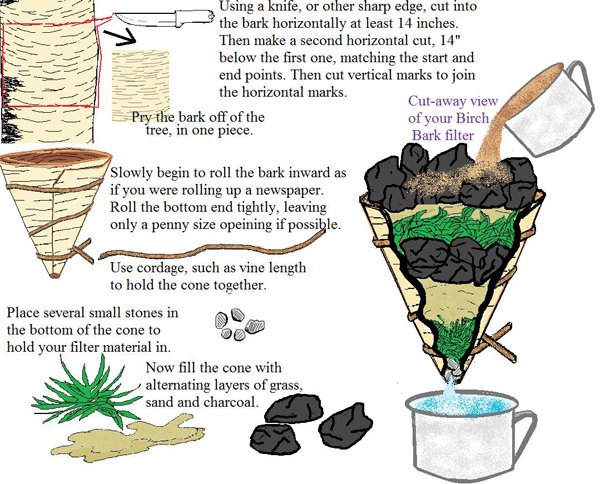|
Filtering Commercially
available water filters:
From a non-primitive survival point of view, there are a
number of good water filters on the market, which will remove
most bacteria as well as giardia.
Primitive survival situations:
In a primitive survival situation, there are a number of
different ways to filter water.
Build a water filter:
You can make a water filter
from a cone of birch bark. This
cone is then filled with layers of sand, charcoal, grasses, and
other materials. Grasses and sand help to trap suspended
particles. Charcoal helps to remove chemical impurities, but not
bacteria (as is sometimes commonly believed). You may
have to pass the water through the filter more than once,
depending on the size of the filter and what it's made of.
Generally speaking, the bigger the filter, and the more layers
you have in it, the better.
The birch bark cone will need to have a fairly small hole in
the bottom. The cone will have to be tied with cordage to keep
it from opening up. Put a few stones in the very bottom, to help
hold your filtering materials in place. Then pour in layers of
charcoal, grasses, sand, and possibly other materials that you
feel will help to filter out suspended particles and perhaps
even bacteria.
Once you have constructed the filter, simply pour impure
water through the filer, catching it in another
container at the bottom.

Diagram Copyright 2008 Leatha S. Warden
Use the Earth to filter water:
This is basically the "well" method of obtaining water. Dig a
hole about 2-4 feet from a water source, such as a river. Allow
the hole to fill with water. The water in the hole will likely
be reasonably pure (but there are no guarantees, though!)
Distilling using a solar still:
This is an excellent method, when sunshine and appropriate
materials (to build the solar still) are available. Build a
solar still (described elsewhere). Then place the impure water
into the solar still pit and allow it to evaporate. It may be
best to use a cloth or other absorbent material to soak up the
impure water, place that into the solar still pit, and allow the
water to evaporate from that.
The water in the pit will evaporate, collect on the underside
of the solar still cover and drip into your collecting
container. |